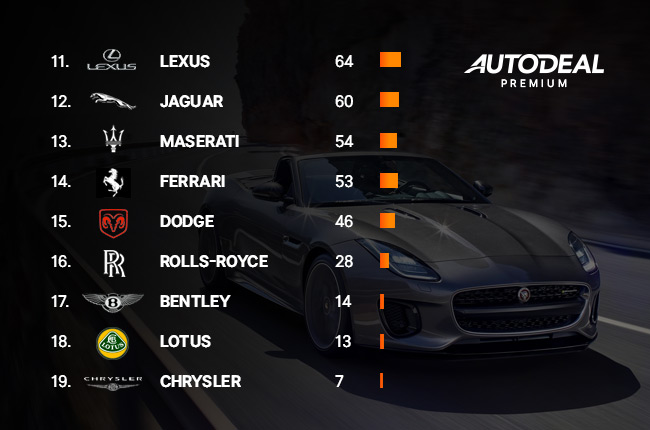The China Factor: Analyzing Challenges For Premium Auto Brands Like BMW And Porsche

Table of Contents
Intense Competition and Local Players
The Chinese luxury car market is fiercely competitive. Established international brands like BMW and Porsche face pressure not only from each other but also from rapidly emerging domestic Chinese automakers. These local players are challenging the established order with innovative designs, advanced technologies, and aggressive pricing strategies.
- Rising popularity of domestic brands: Nio, Xpeng, and BYD are just a few examples of Chinese brands making significant inroads into the luxury segment. Their rapid technological advancements and sophisticated marketing campaigns are attracting a growing number of Chinese consumers.
- Aggressive pricing strategies: Local competitors often undercut international brands on price, making luxury cars more accessible to a wider segment of the Chinese population. This puts pressure on premium brands to offer competitive pricing without compromising their brand image.
- Advanced technology and features: Chinese brands are integrating cutting-edge technology, such as advanced driver-assistance systems (ADAS) and sophisticated infotainment systems, at competitive price points, challenging the perceived technological superiority of established international brands. This necessitates a continuous technological arms race for premium brands.
Understanding Chinese Consumer Preferences
Chinese consumers’ preferences for luxury cars differ significantly from those in Western markets. Understanding these nuances is paramount for success. It's not just about the car itself; it’s about the entire brand experience and the social implications of owning a particular vehicle.
- Preference for technological innovation: Chinese consumers, particularly younger buyers, highly value technological innovation and advanced features. This includes advanced driver-assistance systems, digital connectivity, and cutting-edge infotainment systems.
- Emphasis on brand image and social status: Owning a luxury car in China often carries significant social status and prestige. Premium brands must carefully cultivate their brand image and communicate its association with success and social standing.
- Importance of digital marketing and online presence: Chinese consumers heavily rely on digital platforms for research and purchasing decisions. A strong online presence and targeted digital marketing strategies are crucial for reaching this audience.
- Growing demand for electric vehicles (EVs) and hybrid cars: China is a global leader in the adoption of electric vehicles. Premium auto brands must offer competitive EV and hybrid options to stay relevant in the market.
Navigating the Regulatory and Political Landscape
The Chinese regulatory and political environment presents unique challenges for premium auto brands. Navigating these complexities requires careful planning and a deep understanding of the local rules and regulations.
- Import tariffs and taxes: High import tariffs and taxes increase the cost of imported vehicles, affecting profitability and potentially pricing them out of reach for some consumers.
- Environmental regulations and emission standards: Stringent environmental regulations and emission standards necessitate investments in cleaner vehicle technologies and manufacturing processes.
- Government policies on foreign investment: Government policies regarding foreign investment can significantly impact the operations and expansion plans of premium auto brands.
- Data privacy and cybersecurity regulations: Growing concerns about data privacy and cybersecurity necessitate the implementation of robust security measures to comply with local regulations.
Supply Chain Disruptions and Economic Volatility
The Chinese automotive market, like the global economy, is susceptible to supply chain disruptions and economic volatility. This creates significant challenges for premium auto brands.
- Impact of global chip shortages: Global chip shortages have severely hampered production capacity across the automotive industry, impacting delivery times and sales figures.
- Economic downturns and their effect on consumer spending: Economic fluctuations can significantly affect consumer spending on luxury goods, impacting demand for premium vehicles.
- Geopolitical factors and their influence on supply chains: Geopolitical instability and trade tensions can disrupt supply chains and increase the complexity of operating in the Chinese market.
Conclusion: The Ongoing Importance of Understanding the China Factor
The Chinese automotive market presents significant challenges for premium brands like BMW and Porsche. Intense competition from local players, understanding unique consumer preferences, navigating complex regulations, and managing supply chain vulnerabilities are all critical factors. The "China factor" represents a complex interplay of these elements, underscoring the need for adaptable strategies and a deep understanding of the market's nuances. For long-term success, premium auto brands must prioritize adapting to the evolving landscape, investing in local partnerships, and continually refining their strategies to meet the unique demands of Chinese consumers. Further research and analysis of the China factor are crucial to fully grasp the opportunities and challenges within this crucial market for premium brands. We encourage you to explore additional resources and engage in further discussion on the challenges and opportunities within the Chinese automotive market for premium brands.

Featured Posts
-
 End Of Ryujinx Nintendo Contact Forces Emulator Shutdown
May 11, 2025
End Of Ryujinx Nintendo Contact Forces Emulator Shutdown
May 11, 2025 -
 Montego Bay A Jamaican Vacation Mix
May 11, 2025
Montego Bay A Jamaican Vacation Mix
May 11, 2025 -
 The John Wick Experience Las Vegas Unveiled
May 11, 2025
The John Wick Experience Las Vegas Unveiled
May 11, 2025 -
 Regalo Presidencial Tres Toros Uruguayos Parten Hacia China Para Xi Jinping
May 11, 2025
Regalo Presidencial Tres Toros Uruguayos Parten Hacia China Para Xi Jinping
May 11, 2025 -
 Adio Thomas Mueller Ultimul Meci Pe Allianz Arena
May 11, 2025
Adio Thomas Mueller Ultimul Meci Pe Allianz Arena
May 11, 2025
